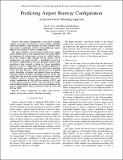| dc.contributor.author | Avery, Jacob Bryan | |
| dc.contributor.author | Balakrishnan, Hamsa | |
| dc.date.accessioned | 2017-01-20T15:45:58Z | |
| dc.date.available | 2017-01-20T15:45:58Z | |
| dc.date.issued | 2015-06 | |
| dc.identifier.issn | 2406-4068 | |
| dc.identifier.other | Paper ID 509 | |
| dc.identifier.uri | http://hdl.handle.net/1721.1/106551 | |
| dc.description.abstract | The runway configuration is a key driver of airport capacity at any time. Several factors, such as weather conditions (wind and visibility), traffic demand, air traffic controller workload, and the coordination of flows with neighboring airport influence the selection of runway configuration.
This paper identifies a discrete-choice model of the configuration selection process from empirical data. The model reflects the importance of various factors in terms of a utility function. Given the weather, traffic demand and the current runway configuration, the model provides a probabilistic forecast of the runway configuration at the next 15-minute interval. This prediction is then extended to obtain the 3-hour probabilistic
forecast of runway configuration. The proposed approach is illustrated using case studies based on data from LaGuardia (LGA) and San Francisco (SFO) airports, first by assuming
perfect knowledge of weather and demand 3-hours in advance, and then using the Terminal Aerodrome Forecasts (TAFs). The results show that given the actual traffic demand and weather conditions 3 hours in advance, the model predicts the correct
runway configuration at LGA with an accuracy of 82%, and at SFO with an accuracy of 85%. Given the forecast weather and scheduled demand, the accuracy of correct prediction of the runway configuration 3 hours in advance is 80% for LGA and 82% for SFO. | en_US |
| dc.description.sponsorship | National Science Foundation (U.S.) (NSF Cyber-Physical Systems project FORCES, grant number 1239054) | en_US |
| dc.language.iso | en_US | |
| dc.publisher | Federal Aviation Administration/EUROCONTROL | en_US |
| dc.relation.isversionof | http://www.atmseminarus.org/seminarContent/seminar11/presentations/509-Balakrishnan_0126150652-PresentationPDF-6-29-15.pdf | en_US |
| dc.rights | Creative Commons Attribution-Noncommercial-Share Alike | en_US |
| dc.rights.uri | http://creativecommons.org/licenses/by-nc-sa/4.0/ | en_US |
| dc.source | MIT web domain | en_US |
| dc.title | Predicting Airport Runway Configuration: A Discrete-Choice Modeling Approach | en_US |
| dc.type | Article | en_US |
| dc.identifier.citation | Avery, Jacob and Hamsa Balakrishnan. "Predicting Airport Runway Configuration: A Discrete-Choice Modeling Approach" Eleventh USA/Europe Air Traffic Management Research and Development Seminar, Lisbon, Portugal June 23-26, 2015. | en_US |
| dc.contributor.department | Massachusetts Institute of Technology. Department of Aeronautics and Astronautics | en_US |
| dc.contributor.mitauthor | Avery, Jacob Bryan | |
| dc.contributor.mitauthor | Balakrishnan, Hamsa | |
| dc.relation.journal | Proceedings of the [Eleventh] USA/Europe Air Traffic Management Research and Development Seminar, ATM2015 | en_US |
| dc.eprint.version | Author's final manuscript | en_US |
| dc.type.uri | http://purl.org/eprint/type/ConferencePaper | en_US |
| eprint.status | http://purl.org/eprint/status/NonPeerReviewed | en_US |
| dspace.orderedauthors | Avery, Jacob; Balakrishnan, Hamsa | en_US |
| dspace.embargo.terms | N | en_US |
| dc.identifier.orcid | https://orcid.org/0000-0003-1128-0039 | |
| dc.identifier.orcid | https://orcid.org/0000-0002-8624-7041 | |
| mit.license | OPEN_ACCESS_POLICY | en_US |
